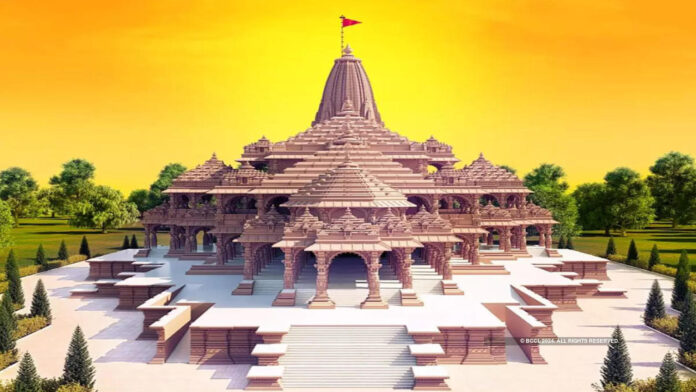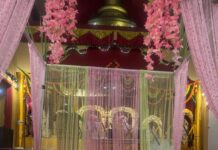India Post News Service
CHICAGO: Highly anticipated consecration ceremony for the Shri Ram Janmabhoomi Teerth Kshetra in Ayodhya, India will take place.
The temple and surrounding complex, the completion of which will take several years, is being built on an ancient site of Hindu worship. The final temple on the site was destroyed in the early 16th century by the first Mughal emperor for the construction of a mosque, known in modern times as the Babri Masjid.
Since the early 19th century there have been Hindu and Sikh efforts to worship Lord Ram on the site. During British rule, the outer areas of the site were given to Hindu and Sikh devotees, with the inner areas remaining for Muslim prayer. Even prior to the establishment of the modern state of India in 1947, there have been a number of court cases concerning the site. In 1949, the government declared the mosque a disputed site, leading to the discontinuation of the mosque’s use.
In the early 1990s this mosque was torn down after a rally at the site turned violent. In 2019 the Indian Supreme Court weighed in, allowing the construction of a Hindu temple on the site to proceed and granting significant land nearby for the construction of a new mosque, which will be the largest in India.
Why is the rebuilding of a temple in Ayodhya at Ram Janmabhoomi important to Hindus? The issue is important for a couple reasons:
The site is considered to be the traditional birthplace of Lord Ram and thus deserves to be honored as such. Archeological and documentary evidence shows that the site has been recognized as a place of spiritual importance for Hindus since time immemorial.
Seeking reparations to re-establish a Hindu temple that had been destroyed as a result of iconoclasm a few hundred years ago has great symbolic and emotional resonance for Hindus in contemporary times. The trauma that this destruction brought has been passed down through generations and continues to impact the psyche of Hindus.
The destruction of thousands of Hindu temples by Muslim rulers has contributed historically and continues to contribute to Hindu-Muslim tensions in India to this day.
Regardless of the diversity of opinions on the temple consecration, Lord Ram and the Ramayana (the Hindu epic about the life of Lord Ram) play a critical role in the spiritual and cultural life of many Hindu Americans. Worship of Lord Ram is particularly strong within the Indo-Caribbean Hindu community, as well as Fijian Hindu community. Even for Hindus where worship of Lord Ram is not the central part of their spiritual practice, such as Shaivite traditions, the re-establishment of a major Hindu temple on such a historic site is cause for celebration.
What is the archeology and history of the site?
The most recent excavations by the Archeological Survey of India show that the Ram Janmabhoomi site has been in continuous use as a sacred site by Hindus and adherents of other Dharma traditions since the second millennia BCE. There is no evidence that the site was used for anything other than sacred purposes during this period, meaning there is no evidence of homes or other dwellings on the site. Excavations have discovered Hindu sandstone carvings and pillars, as well as Shivalinga on the site.
The most recent Hindu temple on the site dated back to the 12th-century and was the largest of temples that had occupied the area.
This temple was destroyed by Babur, the first emperor of the Mughal Dynasty, for the construction of a mosque in 1528. The mosque was originally referred to as Masjid-e-Janmastan (loosely translated as mosque of the birthplace, in reference to the birthplace of Lord Ram).
Excavations also show that this mosque had no foundations of its own and was built directly on top of the Hindu temple that preceded it. In fact, there is some speculation that this lack of solid foundation was partly to blame for the ease in which the mosque was pulled down in 1992 when a peaceful rally grew violent.
During the colonial period, responding to inter-religious violence, the British gave the outer court of the site to Hindus and the inner court to Muslims.
Following Indian independence, the entire site was locked by the government, following an incident in which a Ram murti was placed inside the mosque.
Though sometimes presented as being a recent conflict, the fact is that this site has a long history of Hindus and Sikhs attempting to reclaim the site, dating back to the early 19th century. Furthermore the conflict has been ongoing regardless of the political party in power following India’s independence.
1822 — A court official states that the Babri Masjid was built after the destruction of a Rama temple.
1858 — According to a First Information Report filed by local police on November 28, 1858, a group of 25 Nihang Sikhs entered the Babri Masjid and conducted Hindu rituals and inscribed “Ram! Ram!” on the walls of the Masjid.
1885 — Mahant Raghubar Das filed a suit seeking permission to construct a Ram Temple on the site.
1949 — A murti of Lord Ram was placed in the Masjid, leading to protests from Muslims and the site being closed and declared a disputed site by the government. No Muslim prayers have been held in the site since then.
1950 — Two lawsuits were filed by Hindus for the right to conduct religious rituals and keep murtis of Lord Ram in the site.
1959 — A Hindu spiritual body (Nirmohi Akhara) files a third lawsuit for the right to conduct religious worship at the site.
1961 — Sunni Muslim body files a lawsuit seeking possession of the site and removal of the murtis of Lord Ram.
1989 — A district court orders the site to be unlocked and open for Hindu worshippers.
1992 — On December 6, a rally organized by the VHP and Bharatiya Janata Party (BJP) at the site grew to more than 150,000 people. The Babri Masjid had been cordoned off by police, in an attempt to protect it. By noon, the police cordon was breached, police fled, and within a few hours the mosque, unused for more than four decades, was demolished.
2019 — India’s Supreme Court ordered the land to be awarded to a trust to build a Hindu temple. It also ordered the government to give an alternate five acres of land to the Sunni Waqf Board for the purpose of building a mosque. When constructed the mosque built on this site will be the largest in India. The Shia Waqf Board also intervened in the lawsuit in support of allowing Hindus to build a Ram temple at the site.
2020 — On August 5, 2020 groundbreaking was held for the Shri Ram Janmabhoomi Teerth Kshetra.
2024 — On January 22, 2024 central portion of the new Ram Mandir is consecrated. Full completion of the temple and surrounding complex is expected to take several more years.
Who is Lord Ram?
Lord Ram (also spelled Rama) is the seventh incarnation of Lord Vishnu, and believed to be a historic king. The hugely popular epic poem the Ramayana tells of his exile as the heir-apparent from his kingdom in Ayodhya and later return to that city. The Hindu festival of Diwali commemorates this return.
The events conveyed in the Ramayana portray Rama as an idealized man, son, husband and king and, the epitome of dharma or righteousness. These stories have been told for centuries to teach aspects of Hindu values and virtues.
The Ramayana is the subject of oral and written retellings, devotional music, poetry, art, dance dramas, and even television serials and animated features.
The traditional dating for the era of Lord Ram’s birth is approximately 4300 BCE.
Today there are thousands of temples dedicated to the worship of Lord Ram in India, Nepal, and throughout the Hindu diaspora.







